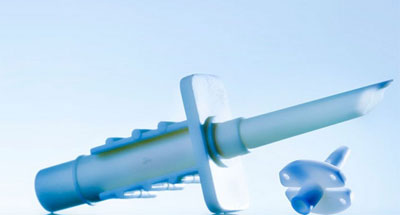|
New Materials
for Medical Devices

New for old : Spike (Flemina)
According to Ineos Styrolution. healthcare application providers are torn in two
directions when it comes to working with new materials.
Healthcare application providers
are torn in two directions when it comes to working with new materials. On the
one hand, they would like to build superior devices to existing ones – or all
new applications that cannot be realised with existing materials. On the other
hand, every new material requires lengthy approval processes.
As a result, new materials should
provide a significant new value proposition to justify the investment in new
applications and devices.
Two main factors drive the value
proposition of a new material in the healthcare industry.
The first factor is related to
the actual physical and chemical properties of the new material. These
properties decide if a product is capable of serving a defined purpose. Details
are listed in technical data sheets. For styrenic materials, for example, the
data sheet may contain dozens of mechanical, thermal, rheological and other
properties.
An important material property
for many materials in the medical industry is the chemical resistance against
drug media. Residual monomer and additive release into the media needs to be
kept to a minimum, and low adsorption and absorption of targeted drugs are very
important drivers when selecting new materials. Styrenic materials traditionally
show a very good performance in this area and Styrolux, an Ineos Styrolution SBC
material, excels with a strong resistance against drug media.
In addition to the material
properties, application providers also pay attention to the ease-of-use of
working with a certain material. ‘Ease-of-use’ describes a long list of criteria
that may be different from material to material and from application provider to
application provider. The list ranges from processability of the material all
the way to services provided by the material provider. It includes topics like
product quality, availability of the material (eg. long-term availability and
early notification of change, reliable deliveries), logistical aspects and many
more criteria. Global application providers may have additional requirements
such
as sourcing across different regions at identical quality.
All-styrenic IV set
Healthcare application providers
constantly look for alternatives for commonly used materials. Having alternative
solutions at hand does not only allow exploring new properties or new
functionalities. They also provide a safety net if tighter regulations demand
shifts towards new solutions.
Ineos Styrolution has proven that
styrenics make ideal materials for a range of healthcare applications – and the
company is constantly growing the number of dedicated solutions for the
healthcare sector. Today, Ineos Styrolution is aiming at developing the first
all-styrenics IV set. Being a dedicated supplier for styrenic polymers in the
healthcare industry, the company is bundling its styrenics IV activities within
its global healthcare team, led by Alexander Silvestre.
Styrenics provide several
properties resulting in a higher efficiency and lower cycle times. These may be
key for an application provider. The key benefits of styrenics include
• easily bonded to other
materials
• a low density resulting in more output
• excellent flowability and processability
• high flow grades
• lower processing temperatures
• limited to no pre-drying
Styrenics provide the additional
benefit of clean incineration after use.
Overall, it can be said that the Ineos Styrolution materials such as Styrolux
and Styroflex show properties that are well balanced making them ideal solutions
for IV sets. In addition to the above list of properties, the materials show an
excellent behaviour in drug absorption tests, in particular in comparison to
traditionally used materials. This includes, for example, a very low absorption
rate for insulin and overall low absorption values for typical drug molecules.
Ineos Styrolution has a strong
presence in this field, with solutions such as
• MABS (Terlux), SMMA (NAS) and
MBS (Zylar), highly transparent materials for connectors
• dedicated Styrolux grades, specifically designed for the use in drip chambers
in IV sets
• the above mentioned Novodur HD M203FC G3 for demanding applications like
spikes and applications requiring structural stability
• Polystyrene and ABS solutions for roller clamps
In addition to these existing
materials, Ineos Styrolution is currently working on material solutions for the
flexible parts of the IV set.
• Materials for tubing are under
development using SBC (styrene-butadiene block copolymer) based solutions (see
references 3 and 4). Important properties for good tubing materials include a
high transparency for visual inspection, good resistance against kinking during
bending to ensure continuous drug feeding and good resilience. The recent
integration of the K-Resin business into Ineos Styrolution’s market leading
styrenic portfolio leverages both companies’ respective strong technical
heritages to create new and innovative customer solutions for medical
applications.
• Materials for IV bags require
film featuring a good puncture resistance, good transparency and they must be
able to be sterilised. The materials also need to feature a defined shelf life,
which is due to high barrier properties. Another aspect is the need for
regulatory approved stabilisation and additive (eg. waxes) packages. First
developments have been reported
(see reference 5). Ongoing
research show that it is crucial to combine puncture resistance with high
temperature resistance and certain barrier properties (provided by polyolefins
and cycloolefins).
Norbert Niessner, global head of
research and development/ intellectual property at Ineos Styrolution, summarises
the ongoing efforts.
“Our development team is closely
linked not only to state-ofthe-art technology to develop and produce innovative
styrenics based materials, we are also in close contact with leading medical
OEMs, thanks to the global presence of our healthcare team. They constantly
provide us with valuable insights into the industry’s needs.”
(Ref :
https://www.medicalplasticsnews.com/news/matter-ofsubstance/)
* * * * *
|

